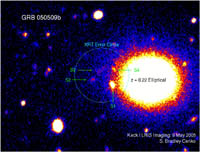Imagine the Universe News - 24 May 2005
NASA Scientists Catch Unique Gamma-Ray Burst
| 24 May 2005 |
After 30 years, they finally caught one. Using the Swift satellite, scientists for the first time detected and pinned down the location of a so-called "short" gamma-ray burst, one lasting only 50 milliseconds.
A gamma-ray burst (GRB) marks the birth of a black hole. In recent years astronomers have discussed two possible causes of GRBs - one is the collapse of a supermassive star in an event called a hypernova. The other is a collision of two older black holes, or two neutron stars.
In addition, astronomers have noticed that there appear to be two types of GRBs. Most GRBs last a few seconds or some tens of seconds. Satellites such as Swift, along with follow-up observations by ground-based telescopes, have shown these to be in young, distant galaxies filled with young, massive stars. Such massive stars are prime candidates for the hypernova model. Other GRBs last a second or less. These have had remained elusive until Swift detected this one, autonomously locked onto a location, and focused its on-board telescopes in less than a minute to capture the burst afterglow.
"Seeing the afterglow from a 'short' gamma-ray burst was a major goal for Swift, and we hit it just a few months after launch," said Dr. Neil Gehrels, Swift project scientist at NASA Goddard Space Flight Center in Greenbelt, Md. "Now, for the first time, we have real data to figure out what these things are."
This burst is called GRB 050509B, being the second burst detected on May 9, 2005. Swift's X-ray Telescope (XRT) detected a weak afterglow that faded away after about five minutes. Swift's Ultraviolet/Optical Telescope did not see an afterglow. Ground-based telescopes have not yet definitely detected an afterglow either. In contrast, afterglows from long bursts linger from days to weeks.
Most importantly, Swift was able to determine the position of this burst to within about 10 arc seconds. GRB 050509B appears to have occurred near a giant elliptical galaxy that has old stars and is relatively nearby (about 2.7 billion light years away). These galaxies are often surrounded by globular clusters, which are dense clusters of old stars. This would be consistent with the theory that short bursts come from collisions of older, evolved neutron stars or black holes.
"Everything about this gamma-ray burst so far supports the merger theory," said Dr. Steinn Sigurdsson, a theorist at Penn State and expert on black hole mergers.
"We are combing the region around the burst with the Keck Telescope for clues about this burst or its host galaxy," said Caltech Prof. Shri Kulkarni, a gamma-ray burst expert. "What we are seeing so far is what proponents of the merger theory have been saying all along. Such an evanescent afterglow has been expected in the most popular model for short hard bursts to date."
Observations by S. Bradley Cenko at the 10-m Keck I Telescope identified possible optical counterparts to the burst. However, subsequent observations showed that none of them varied in intensity, as would be expected. Further follow-up observations are planned with an armada of telescopes, both ground-based and NASA's Hubble Space Telescope and Chandra X-ray Observatory.


